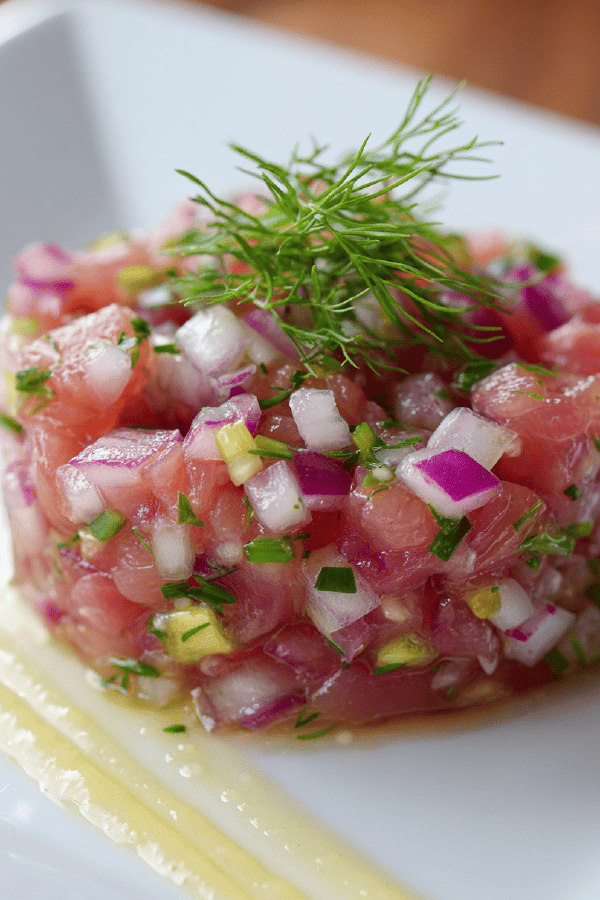Featured Recipe
Salmon Tartare Remix

By Kate
"
Fresh salmon turned into diced raw tartare with a twist: red onion replaces shallots, with fresh dill swapped in for parsley. Tartare mixed in a white wine & lemon marinade, balanced with Dijon mustard and chopped cornichons instead of capers. Touch of garlic oil added for depth. Kept chilled on ice during prep; ready in half an hour. Serves four. No gluten, lactose, eggs, nuts, or dairy. A raw fish dish showcasing bright acid, herbs, and little heat.
"
Prep:
25 min
Cook:
0 min
Total:
30 min
Serves:
4 servings
seafood
appetizer
no-cook
French
Introduction
Raw fish diced small. No fuss. You want fresh salmon first. Cold. Red onion over shallots now. Sharp instead of subtle. Dill instead of parsley. More fragrant, more pine-y, mixed in. Tart lemon juice joins vinegar, water to soften. Olive oil slick to coat. Dijon mustard adds texture, bite. Cornichons chopped in replace capers. That crunch. Bit of garlic oil for umami twist. Tabasco, cautious. Chill the mix while prepping. Keep cold to keep taste bright and safe. Ready fast, about half an hour from start to finish. No cooking, just mix and eat. Served with greens or crispy bread—your pick. No dairy, no nuts, no gluten, no eggs. Light, fresh, herbs tickle tongue, fish melts in mouth instead of chewy. The acid wakes everything. Simple, quick, sharp.
Ingredients
About the ingredients
Freshness of salmon is key. Buy sashimi-grade if possible, cut into small even cubes for better eating texture. Red onion replaces shallots for more pungency; soak briefly in vinegar and lemon water mix to mellow harsh edges while retaining crunch. Cornichons swap capers, adding both acidity and texture contrast. Dill offers brighter, resinous herbal notes instead of mild parsley. Garlic oil (not raw garlic) adds background savoriness without overpowering. Mustard thickens and binds flavors, adding grainy texture. Olive oil must be good quality, fruity but mild. Tabasco optional, adjust to taste. Ice setup keeps salmon cold during prep, crucial for food safety and texture. Salt and pepper balanced for clean seasoning without muting freshness.
Method
Technique Tips
Use two bowls, ice setup first. Keeps fish chilled throughout mixing. Cut salmon on chilled board if possible. Mince onions fine, macerate briefly with vinegar and lemon water; drain liquid — too much moisture dilutes texture. Mix everything gently to prevent mashing fish. Add oils last for even coating. Taste before seasoning salt and pepper. Serve immediately to keep colors bright and fish fresh. Do not prepare too far in advance. Let flavors marry only briefly. Serve with simple sides to highlight raw salmon flavors. No cooking means detail on sanitation and chilling steps important. Keep fish cold, prep on clean surfaces. Quick marination ensures acid softens onions, not salmon.
Chef's Notes
- 💡 Always buy sashimi-grade salmon. Fresh is crucial here. Define what is fresh. Look for bright color. Smell is important too.
- 💡 Red onion can be sharp. Soaking in vinegar with lemon juice gives milder taste. Retains crunch though. Important step, do not skip.
- 💡 Dijon mustard not just for taste. Adds texture and binds flavors. Essential for balance. Cornichons provide crunch. Use good quality.
- 💡 Keep everything chilled while prepping. Ice bowl is more than a tip. It matters. Prevents fish from warming up. Safe and flavors stay bright.
- 💡 Serve immediately after mixing. Freshness is key, colors stay vibrant. Plan side dishes to enhance. Simple greens, crusty bread work best.
Kitchen Wisdom
What if salmon isn't fresh?
Freshness is non-negotiable. Always smell fish. Visual checks matter. If off, don't use it.
Can I make this ahead of time?
Not really. Best served immediately. Too much time, fish loses texture. Flavor falters.
How do I store leftovers?
Avoid long storage. Keep in airtight container. One day max. Shrinks quality. Texture changes.
What if I don't like dill?
Swap with other herbs. Cilantro or basil could work. Adjust to your taste but keep experimenting.



